
by Alex A. Kecskes
Tired of swallows building mud nests in the corners of your front porch? Had it with birds nesting in attics, eaves, vents and awnings? Fed up with trying to wash bird nests and their droppings off your walkways, lawn furniture, BBQ and cars? And even after you do, the stains remain! You’re not alone. Thousands of property owners across the country face the same dilemma.
Birds generally build nests that are inaccessible, hidden, or camouflaged. Though in some cases, birds will build nests on top of chimneys. They like the heat produced by chimneys. Other birds are drawn to a chimney’s cavity shape, which they find ideal for nesting.
If you have a flat “under-hang” over your porch, it makes an ideal sheltered spot for birds to nest, and it can be nearly impossible to get rid of birds once they settle in. No matter how many times you knock down their nests, they’ll come back.
There are lethal ways to keep pest birds from nesting on your property. But you should be warned that the Migratory Bird Treaty and Endangered Species acts prohibit the trapping, possession, or killing of most birds, their eggs and nests without a permit. Only house sparrows, starlings and pigeons are unprotected by state or federal law; however, local ordinances may still protect these birds. So check with local authorities before you take action against birds or their nests.
Your other alternative is to use humane and non-lethal bird deterrents to discourage nesting. One property owner hung a series of small mirrors under the eaves of his home where pest birds often chose to nest. When birds came to build a nest, they saw their reflection, got tricked into thinking another bird had already claimed the space, and moved on. Of course, there are other equally effective bird deterrents if you don’t fancy covering your house with mirrors.
To keep swallows, starlings, pigeons, seagulls and other pest birds from nesting on ledges, eaves, beams and similar areas, there's the Bird Slope. Birds slip and slide right off these angled, slippery PVC panels. And if they can’t get a foothold, they soon get frustrated and leave. The best bird slopes are U.V. protected to stand up to extended periods of weathering and sunlight. They’re easily mounted on the underside of eaves with special mounting clips. Some bird slope panels have a "snap-on" extender to streamline installation on wider ledges and coverage areas. Mounting clips are also available for vertical installation on the sides of buildings. You should use the “end caps” provided by some manufacturers to keep birds from getting behind the sloped panels. Architects like to use these sloped panels because they are less visually obvious that other bird deterrents, and because they come in stone and grey colors to better blend in with a building’s color scheme.
To discourage pest birds from building nests atop chimneys, install stainless steel bird spikes. They prevent birds from landing. And if they can’t land, they can’t build a nest. The spikes come in 3-, 5- and 8-inch widths. They’re easy to install and you’ll typically only need a single strip of spikes to cover your entire chimney.
To keep birds from building nests on patio covers, awnings, gazebos and other flat surfaces, some homeowners have had considerable success with Bird Spiders. These versatile bird-proofing devices feature stainless steel “arms” that whip around in the breeze. No bird in her right mind would build a nest near such a threatening display. Spiders come in various sizes--usually 2-, 4-, 6- and 8-foot designs to provide increasingly wider diameters of deterrence. Spiders do a nice job in discouraging pigeons, seagulls, and larger birds. They are easy to install and move, and there’s nothing to replace or maintain once they’re up. The best spiders will feature a U.V.-protected polycarbonate base and come standard with a glue-on base, allowing them to be glued down permanently to flat most surfaces.

As a homeowner, you know the problems pest birds can create when they’re allowed to roost and nest in eaves, canopies, awnings and other covered areas around your home. The beams of your patio cover, gazebo and other elevated backyard structures offer an ideal sanctuary for birds. These areas protect them from weather and predators. Unfortunately, when birds gather there, they create quite a mess down below—on your patio table, chairs, BBQ, walkways, spa, pool and thru-window serving bars. Kids toys can also become covered with disease carrying bird droppings.
Fortunately, there are a number of effective and humane bird control products you can use to keep birds away from your eaves, canopies and awnings:
Garden Bird Netting
A lightweight, easy to handle mesh, Garden Bird Netting physically denies pest birds access to specific areas of your home. It comes in 14 x 100-foot and 14 x 200-foot rolls and can easily be cut down to the size you need. It’s also available in three different "mesh" sizes: 1/4", 1/2" and 3/4" mesh. The netting installs easily under eaves and other areas, and bird netting clips are available to further speed installation. The best garden bird netting is made from a durable, UV-protected polypropylene. It’s strong, lightweight, designed for temporary use and practically invisible.
Bird Slope
Another bird control product that effectively denies birds access to your eaves is Bird Slope. The angled PVC panels won’t allow birds to gain a solid footing on its slippery surface. After a few tries of “squirrel-caging” on the panel, birds just give up and move on. Bird slope panels come in different colors to blend in with your home’s exterior. The panels are easy to install using glue, nails or screws and they're basically maintenance free.
Copper Stuf-Fit Mesh
If your home has a number of small holes and crevices under the eaves and other architecture, Copper Stuf-Fit mesh will keep birds out. It works great for all those tight spaces too small for regular netting or other bird control products. The mesh comes in 20-foot and 100-foot roles and can be “shaped” to conform to the area needed to keep birds out. Stuf-Fit mesh holds its shape in small, narrow areas so birds can’t “work” their way around it. The mesh can even keep birds from getting under your roofing tiles, retractable awnings, and junctions where pipes enter your siding or foundation.
No Nasty Nest
Simple but effective, No Nasty Nest uses hanging "twine" to block birds from potential nesting sites. Confronted with working through a gauntlet of twine strips, birds will simply move on to a better nesting spot. If you had swallow mud nests under the eaves and sides of your home last year, No Nasty Nest makes a great bird deterrent. Each strip of No Nasty Nest features a self-adhering back for quick application on eaves, gables, entryways and other areas.
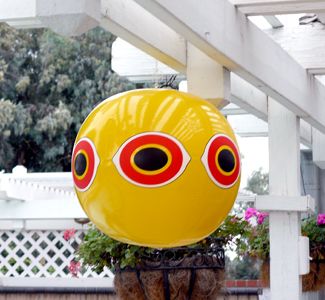
by Alex A. Kecskes
Pest birds have pooped all over your new statue. They've covered your sign with "dried mayo," and someone has threatened to sue you for slipping on bird poop as they entered your property. You've had it with the invasion of these fine-feathered "friends." You're ready to stick your head out of your window and yell, "I'm mad as hell and I'm not going to take it anymore!"
Relax. There are many ways to scare birds away. And keep them away. Without resorting to poisons or firearms. They run the gamut from economical to high-tech. Most can be used in any location or circumstance. Best of all, they're humane and effective in discouraging a wide range of pest birds from landing, pooping and nesting on your property.
Since the economy is in a downturn, we'll start with the simplest, most economical bird guard--the Bird Scare Products. These "shoo" birds away by capitalizing on their fear of shiny things that jostle in the wind. They include iridescent reflective foil or flash tape, scare balloons, banners and the like that serve to create an “Optical Distraction Zone” for most pest birds. Some bird scare balloon chasers have giant eyes that look predatory and threatening. All are easy to install and won't harm birds. They're ideal for gazebos, overhangs, patios, vineyards, parks, pool and spa areas, boat docks and other open areas.
The Bird Diverter, uses scare-eye images to deter pest birds. Like the chaser, they're simple to install and surprisingly effective. Some bird diverters serve double duty, with iridescent foil eyes to scare birds by day and glow-in-the-dark on the flip side to shoo them away when it gets dark.
Last but not least are the higher tech solutions, bird deterrents that scare birds using sound.
When it comes to sound, today's sound bird deterrents can be quite effective. Some audio bird guards create shrill predator and bird distress calls to scare birds away. Others just produce annoying sounds that drive birds away. All are ideal for enclosed areas like parking garages, sheds and overhangs to deter a wide range of pest birds, including sparrows, starlings, pigeons, seagulls and larger birds.
So, if you're troubled by pest birds, you don't have to take it any more!

by Alex A. Kecskes
Tired of hosing off bird droppings from your car/SUV/camper or boat? Have you run out of car soap in scrubbing off bird poop? Unless you’ve implemented effective bird control measures to keep pest birds off your vehicles and boat, these acidic droppings will eat into the paint and cause permanent damage. So you’re more or less stuck whipping out your hose and sponges every day, cleaning off those smelly droppings—droppings that can carry any of 60 known diseases.
Bird droppings damage paint when the cooling paint lacquer contracts and hardens around their deposits. When exposed to sunlight, bird droppings dry and harden. At the same time, paint lacquer heats up in sunlight, causing it to soften and expand. When the paint lacquer cools down at night, it contracts and hardens around bird droppings. Left for any length of time, the droppings will eventually etch the paint.
Some vehicle and boat owners have resorted to canvas covers. But these, too, must be cleaned often or the bird droppings will harden, weaken the fabric and cause it to rip and tear. Vehicle covers, especially boat covers, are not cheap.
Fortunately, there are a number of bird deterrents you can use to keep pest birds off your vehicles and boats parked in your driveway. The two most popular bird control measures include:
Sonic Bird Deterrents
While they may not have raebbit ears, birds have very acute hearing. They’re always on the alert for a fellow bird in distress or the threatening shriek of an approaching predator. Sonic Bird Deterrents deliver the message, broadcasting recorded distress and predator calls that make birds far too nervous to stay around your driveway. The sounds they emit resemble normal bird sounds to humans, so you don’t have to worry about neighbors complaining or your dog or car rushing for cover. The best sonic deterrents will be versatile enough to emit a number of sounds. One sonic bird deterrent currently available can generate distress and predator calls for 22 different species of birds. It’s basically “dial sound” and forget about pest birds. Look for sonic deterrents that feature a built-in speaker, a volume control, and one that lets you program it to turn on or off at night.
Bird Scare Deterrents
If you’re on a budget, these versatile bird deterrents will keep pest birds away from your vehicle or boat. They include inflatable balloons--covered with predator eyes—that sway in the breeze to convince pest birds there’s a big predator just aching to eat them. Scare eye diverters are similar to balloons in that they feature a big eye that spooks birds even thinking about landing on your car or boat. For best effect, you would typically hang these deterrents from your garage (for cars/SUVs), or tied to your covered boat or camper. Just make sure you move them about from time to time or birds will get wise to them.
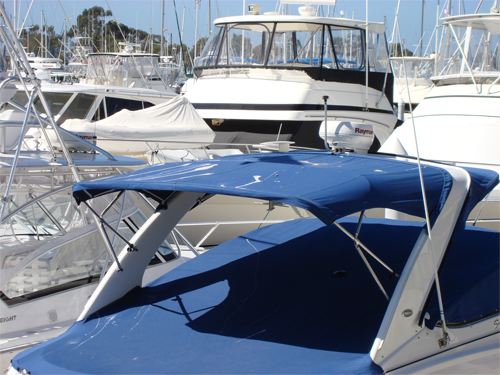
Birds can be a costly nuisance around boats and marinas. When they perch and roost on seaside structures, bird droppings can deface and damage signs, windows, rooftop HVAC units and rain gutters. Docks, railings, walkways, boat houses, pilings and swim platforms can quickly become inundated with bird droppings, leaving an unsightly mess that can create a slip-and-fall hazard. Large birds like gulls, geese, ducks and cormorants can “unload” sizable droppings that require frequent and costly cleanups.
Without effective bird control, boat owners and boat rental outfits need to constantly clean their boats of droppings. Left to accumulate, these droppings can damage boat covers, spreaders, window gaskets, sails, outboard engines, sliding doors, deck surfaces and antenna arrays.
Both boat owners and seaside businesses need to be proactive when it comes to bird deterrents. Achieving effective bird control calls for proven devices that deter birds humanely and keep them away. Here are some devices you should consider to keep pest birds away from your boat or marina business:
The Repeller 360
Using a large, wind-powered sweeping arm, The Repeller 360 is designed to keep large birds like pigeons, crows, gulls, cormorants and raptors away from both boats and marina structures. The Repeller 360° is “armed” with large, reflective “predator eyes” that add to its threatening appearance and function. The device is easy to set up on virtually any flat surface. Rotating continuously in the slightest breeze, The Repeller 360 covers a full 6-foot diameter to keep birds away.
Bird Spiders
Also wind powered and quite effective, Bird Spiders feature wildly flailing arms that whip about in the breeze to frighten birds away. A few bird spiders placed strategically on rooftops, canvas covers and boat decks will cause gulls, cormorants, pelicans and pigeons to simply move on. Bird spiders come in 2-, 4-, 6- and 8-foot diameter arm lengths to create wider and wider circles of deterrence. The best bird spiders are made in the USA and feature a glue-on base for effortless mounting. These spiders will also have a UV-protected polycarbonate base for lasting durability in harsh water-front weather. Removable sand bag bases are also available, which let you set bird spiders up virtually anywhere. Additional mounting bases allow for easy placement on masts and radar units.
Stainless Steel Bird Spikes
Used by boat owners and marinas worldwide, Stainless Steel Bird Spikes provide anti-perching, ant-roosting protection for rooflines, parapet walls, signage and other lofty areas. Installed on boats,they prevent birds from landing on masts, rooftops, and areas around antenna systems. The most rugged and seaworthy bird spikes are made in the USA of stainless steel, with pins embedded in a UV-protected polycarbonate base. These spikes are guaranteed for 10 years. The spikes come in 1”, 3”, 5” and 8” widths and have a 1.5” base, which allows you to mount the spikes on very narrow surfaces. The best spikes also have a built-in a glue trough and feature pre-drilled mounting holes for fast, easy installation.
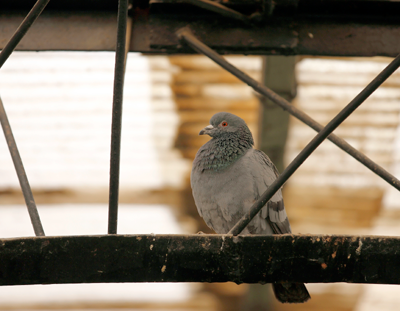
by Alex Kecskes
If your home has a separate garage or shed, you probably have pest birds roosting and nesting either inside or under the eaves. Birds love to perch on the rooftops and exposed beams of these structures. And unless you deter them with some bird control device, birds will continue to gather in greater numbers in and around these structures. Eventually, birds will even start to nest and roost under the eaves of your home.
The longer you wait to implement some effective bird control measures, the more brazen the birds will become. They’ll start to gather in your back yard and leave droppings all over your pool, spa, patio, and BBQ. Keep in mind that birds can carry any of 60 known diseases. If you have children or pets, you’ll be cleaning up the bird droppings on a daily basis.
The good news is that there are a number of humane and effective bird deterrents that you can use. Here are a few that you should look into:
Garden Bird Netting
Lightweight and easy to handle, Garden Mesh Netting will block birds from specific nesting sites around your shed or garage. It comes in 14 x 100-foot and 14 x 200-foot rolls, but you can easily cut it down to the size. It’s also available in three different "mesh" sizes--1/4" mesh, 1/2" mesh and 3/4" mesh. It’s easy to install under eaves and other areas, especially if you use the bird netting clips that are recommended. The netting is made from a durable, UV-protected polypropylene. It’s strong, lightweight and virtually invisible.
Bird Slope
Scientifically designed to keep pest birds away from eaves and similar nooks and crannies, Bird Slope are slippery PVC panels that mount under eaves to prevent birds from gaining a foothold. They scramble and “squirrel-cage” with their little toes and finally give up, moving on to other more hospitable areas. The best bird slope panels are UV protected and sun- and weather-resistant to last longer. Bird slope is ideal for deterring a wide range of birds—including swallows, starlings, pigeons and seagulls. The panels blend in with most architectural styles and they’re now available in two colors--stone and grey.
Copper Stuf-Fit Mesh
Ideal for keeping pest birds out of small holes and crevices, Copper Stuf-Fit mesh creates a physical barrier that blocks out birds. It’s ideal for use in openings and tight spaces too small for regular netting or other products. The mesh comes in 20-foot and 100-foot roles and can be “formed” into the shape of the area needed to deny birds access. The wire mesh will hold its shape in tight areas to prevent birds from “working” their way around it. It can also be used to block birds from getting under roofing tiles, retractable awnings, and where pipes enter siding or foundations.
No Nasty Nest
Ideal for use in blocking swallows, No Nasty Nest consists of hanging "twine" that denies birds access to nesting sites. Faced with wading through the twine strips, birds will simply move on to a better spot to nest. If you have swallow mud nests under the eaves and sides of your garage, shed or home, you’ll want to get this bird deterrent. Each strip of No Nasty Nest has a self-adhering back for fast application on eaves, gables, entryways and other areas.
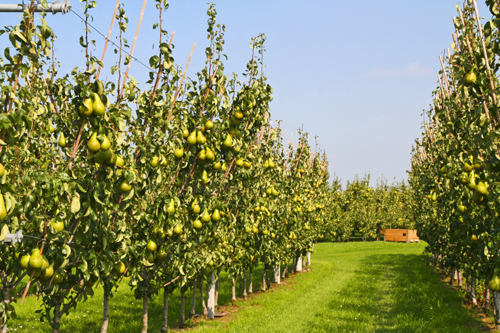
by Alex A. Kecskes
A beautiful garden can be a joy to behold. It reflects the hours of work and care you put into it—the feeding and weeding and spraying for bugs. But unless you exercise some form of effective bird control, your well-tended garden can quickly be ruined by pest birds. Vegetable and fruit gardens are particularly vulnerable. While a few songbirds can add a certain ambiance to a garden, gathering flocks of birds—like crows, pigeons, finches—can destroy ripening fruit and vegetables. They can leave droppings everywhere, turning your garden into a smelly, disease-carrying mess.
The only way to protect your garden is with proven effective bird deterrents. And the best way to ensure your garden won’t be attacked by flocks of pest birds is to implement these bird deterrents before your fruits and vegetables ripen.
Here are three of today’s most popular and effective pest bird deterrents:
Plastic Bird Netting
Creating a physical barrier that denies birds access to specific areas of your garden, Plastic Bird Netting offers a humane, low profile bird deterrent. The netting usually comes in 14 x 100-foot and 14 x 200-foot rolls and three different mesh sizes. There’s a 1/4-inch mesh for smaller birds and a 1/2-inch mesh and a 3/4-inch mesh for larger birds. The best plastic bird netting is fabricated from durable, U.V.-protected polypropylene. This netting is strong, light, easy to handle and virtually invisible.
Install bird netting before your garden bears fruit or vegetables. Suspend the netting over your bushes or vines by at least 6 inches. Protect vegetables by wrapping individual plants in netting or suspend the netting around an entire garden area. To safeguard fruit trees, measure the circumference of the tree and cut the net to size (allow at least one foot extra around the circumference). Secure the netting with twine, zip ties, or hog rings.
Sonic Bird Deterrents
These devices broadcast bird distress and predator calls that make birds feel too uneasy to stay in your garden. The sounds resemble normal bird sounds, so they won’t irritate your pets, friends or neighbors. One highly versatile sonic system can emit distress and predator calls for 22 different species of birds. This unit covers up to an acre of land and can be programmed to turn on or off at night.
Visual Bird Deterrents
Ideally, you would want to use Visual Bird Deterrents in conjunction with the two deterrents mentioned above. These consist of Flash Tape and Reflective Banners, which reflect sunlight and snap in the breeze to make birds too nervous to feed. Also included in this category are Scare Eye Diverters and Bird Scare Balloons—both feature large predator eyes to intimidate pest birds. Visual bird deterrents attach easily to patio covers, gazebos, tree branches, or any elevated area in your garden. Just remember to move them around frequently to convince birds they are “live” threats.
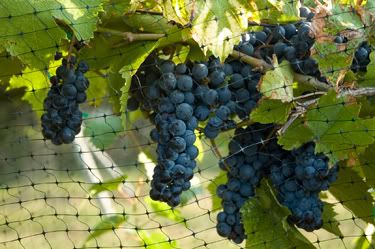
by Alex A. Kecskes
As a homeowner, you know that pest birds can cause considerable damage to your garden. Fruits are especially vulnerable and can be quickly ruined by even a few birds.
Today, 95 percent of all American gardens grow tomatoes. One woman in North Texas suffered extensive damage to her tomato plants by mockingbirds. As soon as her tomatoes got red, ripe and ready to pick, the birds would take bites out of them. They would continue to nibble on her tomatoes all day long. A great-looking tomato, almost ready to pick in the morning, would be ruined with bite marks by late afternoon. Effective pest bird deterrents would have saved her tomatoes.
A sure sign that birds are attacking your fruit is the presence of holes throughout. Starlings and blackbirds can eat the fruits and vegetables you worked so hard to grow. Canada geese will munch on your grass and leave nearly a pound a day (per goose) of droppings. Birds can also damage your favorite trees. They’ll rip through bark searching for bugs. Few plants are safe from pest birds. They’ll use their beaks to rip, tear and tug your plants pieces.
The temptation is to resort to lethal bird control measures—like BB guns and poisons (avicides). But if you have pets or children, these methods are highly undesirable as well as being inhumane to birds. Fortunately, there are a number of bird deterrents on the market that are both effective and humane. They’re ideal for keeping pest birds out of your garden. Here are three proven bird control measures:
Lightweight Plastic Bird Netting
Plastic bird netting lets you exclude pest birds from garden, enclosed courtyard, patio or similar area. The netting comes in various mesh sizes to block out pigeons, sparrows, starlings, seagulls and other birds. The best high quality bird netting is available in various colors to blend in with your garden’s décor. One manufacturer offers a bird netting kit for fast, easy installation. The kits include perimeter cable, cable crimps, turnbuckles, intermediate attachments, hog rings, and accessories and tools.
Sonic Deterrents
These devices generate distress and predator calls that make birds too scared to hang around and feed. One commercially available system can generate such calls for 22 different species of birds. The calls, repeated every 10 minutes, resemble natural birdcalls to humans and won’t irritate pets. You can set a volume control to generate from 65-105 decibels, and you can program the unit to turn on or off at night. The best bird sonic units come with a built-in speaker that protects gardens up to an acre.
Bird Scare Deterrents
These inexpensive bird deterrents create an “Optical Distraction Zone” that makes pest birds too nervous to hang around your garden. They consist of reflective foils, shiny tape banners and balloons that are easy to install. Some balloons have giant predator eyes to give birds that “spied on” feeling. Balloons can also be filled partially with water to skim the surface of swimming pools, spas and Koi ponds.

by Alex A. Kecskes
If your home has been besieged by gulls, you know what a nuisance they can be. These scavengers will eat just about anything that’s on your patio, boat dock or backyard. That includes fish, insects, mollusks, worms, mice, young birds, bird eggs, and berries. When gulls feast and gather, they'll leave an awful mess. They can cover your backyard and patio area with smelly, disease carrying droppings and rotting fish. If they use your rooftop to tear apart their prey, they can dislodge and damage roofing tiles and other rooftop structures.
Like most birds, it’s not just one type of gull you have to worry about. There are over 45 species of gulls. Your typical gull is a medium to large bird with a mostly white body and grey or black markings on the wings and tail. Their stout, orange bills and webbed feet make them easily recognizable. While gulls are often found near large bodies of water like bays, inlets and lakes (as well as the ocean), they have been known to venture inland for food. So don’t be surprised to see them on the roof of your home or patio if your home is miles inland.
To keep gulls away from your home, you should first remove any open food source such as open trashcans or pet food. After that, you’ll need some effective bird control measures to keep them away. Here are three bird deterrents the pros use:
Bird Spikes for Gulls
Gulls regularly choose the roof of a home or structure to roost on. The peak of a roof is an especially desired area as it provides a nice look out point for food and predators. Bird Spikes are a humane product used to keep gulls off roof lines, parapet walls, pilings and other areas. Bird Spikes simply create an uneven surface that gulls know they cant land on. Spikes that are pre-assembled, such as the Stainless or Plastic versions are easiest to install.
Bird Spiders
Bird Spiders have spindly arms that whip about in the wind. Gulls see these and will simply move on to a friendlier landing perch. Bird Spiders are easy to set up on decks, posts, atop light fixtures, rooftops, fixed umbrellas and awnings. These bird deterrents are available in 2-, 4-, 6- and 8-foot arm lengths to create larger and larger areas of bird deterrence. Look for bird spiders that feature a glue-on base, which can be attached to most surfaces.
Sonic Gull Control
No gull likes to hear his fellow gulls being attacked. Or the sound of Peregrine falcons screeching in for the kill. Bird Sonic Deterrents exploit these fears and drive gulls away. These devices broadcast prerecorded distress and predator calls that resemble normal bird sounds to humans. One popular device features a built-in speaker that covers up to one acre. The unit can be programmed to turn on or off at night, and you can even adjust the volume.

By Alex A. Kecskes
You just got a new sailboat for the summer. And you plan on taking it out with friends and family, maybe even the boss. The boat’s all shiny and new. The sails are spotless. Every inch of your new boat says: I care about this vessel. But then you look at the boats on either side of your dock. They’ve been around for awhile. And they’ve endured the ravages of pest birds—the seagull nests, feathers and droppings, the dead fish scraps. You ask yourself: Will my boat be next?
If your boat’s moored in the Cape Cod area, you can expect an invasion of cormorants from the end of August till sometime in October. These annoying birds will sit on any thin, horizontal wires or structures. They don't sit on decks but on your spreaders and create a huge, smelly mess. The mix of fish fat and calcium from fish bones is worse than any glue. The only way to get it off is to sand it off.
If your boat’s moored on the other coast--in San Diego--you can expect major problems with Sea Gulls, Pelicans and Blue Herons landing on your fore deck, dodger and bimini. You may also have occasional problems with Pelicans landing on the masthead.
The solution is to implement an effective bird proofing strategy for your boat. Do this and while you may have an occasional dropping from a fly-over, pest birds will no longer just sit and poop on your boat. Here are a few simple time-honored pest bird deterrents that you can use to keep your boat clean and sanitary:
Bird Netting. Often sold to growers to protect trees and plants, lightweight bird netting can be highly effective in excluding pest birds from your boat. The netting is typically black and hard to see from a distance. Some sailors drape a section of netting over the boom and clip it to the side rails with clothespins. You can cut off a section for the fore deck and attach at several key points—leaving just a bit of slack. You’ll find that most birds simply won't land on the unstable netting. Best of all, netting is easy to put and take down in minutes. Good bird netting will last you for several seasons.
Bird Spiders. Gulls, especially, hate these devices because the flagellating stainless steel “arms” whip around in the breeze and that makes them extremely nervous. Spiders are available in 2-, 4- and 8-foot diameter arm lengths to offer ever-expanding areas of protection. They are easy to install and have no moving parts to wear out. Choose bird spiders that have a U.V.-protected polycarbonate base—they will last longer. One manufacturer offers a bird spider that comes pre-assembled. Some spiders come with a glue-on base, so they can be glued down permanently to most flat surfaces. You can also get railing mounts for easy attachment to boat rails. Other attachments include a bag base that gives you the freedom to place the spider practically anywhere, including on your canvas covers and biminis.
Visual Bird Deterrents. These include reflective foil banners and strips as well as blow-up balloons. The strips and banners tend to crackle in the breeze and sparkle in the sunlight, which makes pest birds think twice about landing on your boat. Balloons covered with large predator eyes are no less intimidating. These devices are inexpensive and simple to install. One tip: string banners every few feet from your fore and aft halyards.
Solar Bird Repeller. This is for all you boat owners who like hi-tech gadgets. Yet unlike many high tech gadgets, this one really works to sweep pest birds off your boat. Best of all, it does the job on solar power! The continuously rotating 5-foot diameter arms keep even the largest pest birds at bay—including gulls, pigeons, and crows, cormorants and vultures. The two adjustable “arms” turn continuously at 30 RPMs. Solar Bird Repellers can be placed wherever they're needed to deter pest birds. They can even store the sun's energy to keep turning all night.
|










 RSS Feed
RSS Feed